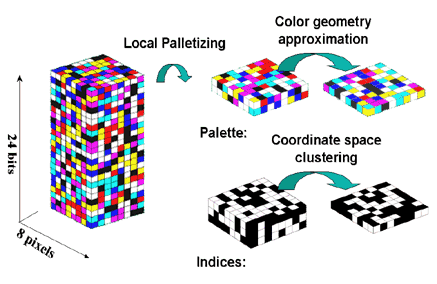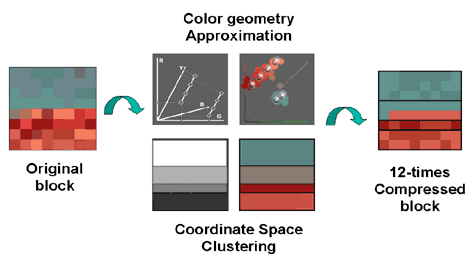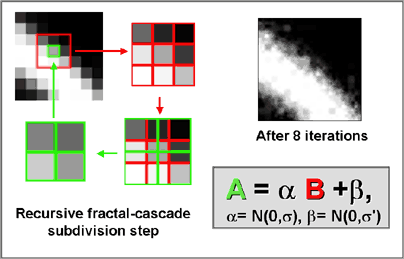From October 1998 to December 1999, a project called "Multiresolution
texture compression and synthesis" was successfully performed in the
Laboratory under contract with Intel Corporation.
First stage of the project was improvement of the popular “zero-tree”
wavelet-based image compression algorithm. Afterwards the work
concentrated around the two main problems:
-
development of the texture compression method providing fast access
to arbitrary pixel in compressed image file
-
development of the technology for fast and resolution-independent
generation of textures with desired properties
At the same time we created a system for evaluation of the compressed images quality.
Texture Compression
The problem of texture compression with fast access to pixels was
solved by developing an algorithm that compressed small (8-by-8
pixels) image blocks independently. The main idea was to use a set of
local palettes for each block. Starting from a local palette of eight
colors, more compact representation was developed, using 3 times less
space for indices and 2 times less space for colors.

Compression of indices was achieved by partitioning the block into 4
independently palletized subsets (“clusters”), using only 2 or 4
colors for each cluster. In combination with original format of the
palettes (sets of vectors in color space) representation, this allowed
to obtain compression ratio 8 or 12, depending on local palettes
format.

Well known format S3TC with similar functionality provides only 6
times compression. Results of the work were presented at ACM
conference "Multimedia 2000" in Los-Angeles.
-
Leonid Levkovich-Maslyuk, Pavel G. Kalyuzhny, Alexander Zhirkov. "Texture Compression with Adaptive Block Partitions". ACM Multimedia 2000, Los-Angelos.
-
A. Pereberin "Hierarchical Approach for Texture Compression". GraphiCon'1999.
-
S. Titov "Perceptually Based Image Comparison Method", Graphicon'2000.
Cascade texture generation
We have developed two algorithms for texture generation.
First of
them, the cascade process, is described here. Under this process every
pixel of the coarse version of the image is split into finer version
pixels, using the predefined distribution of weights, as well as
information of the adjacent pixels colors. The weights are chosen so
as to satisfy the assumption of the image self-similarity, in
particular, the energy distribution over the coarse pixel should be
similar to energy distribution over the pixels of the surrounding
3-by-3 block (as shown in the picture). Similarity coefficient in the
color space is chosen to be nonstationary, because for coefficient
values < 0.5 the iterations converge to a smooth function; if the
coefficient is too large, the resulting image becomes chaotic. In the
suggested process we used normally distributed coefficients and
stationary additive noise.

Changing the process parameters, one obtains textures with various
statistical properties. When applied to natural starting image, the
algorithm produces its “magnified version”, so that textured areas
look approximately the same, and contours and edges are blurred
according to “magnification”, i.e. look as if seen under microscope.
Picture below shows original fragments of textures (left), and
magnified textures after 3 iterations of the algorithm.
Team of researchers
Leonid Levkovich-Maslyuk was Principal Investigator to the project.
Group consisted of the (then) students Alexander Zhirkov, Pavel
Kalyuzhny, Sergei Titov, and PhD student Anton Pereberin
- Leonid Levkovich-Maslyuk (Senior Scientist, The Keldysh
Institute of Applied Mathematics, RAS)
(levkovl@spp.keldysh.ru)
- Alexander Zhirkov:
wavelet image compression, cluster texture compression, texture
generation by the recursive fractal cascade partitioning
(zh@graphics.cs.msu.su)
- Pavel Kalyuzhny:
cluster texture compression
- Sergey Titov:
compressed and original image comparison with the aid of ‘perceptual metric’ in LUV color space.
- Anton Pereberin:
wavelet transforms, multiresolution texture generation with the aid of structuring image elements